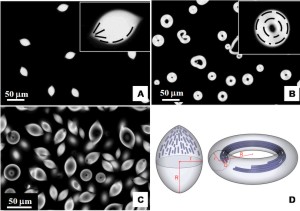Dense multicomponent systems with macromolecules and small additives attract a broad research interest because of the rich
spectrum of physical effects and because they mimic the molecularly crowded cellular interiors. The physics involves the excluded
volume effects and screened electrostatic interactions. In typical systems, such as the Onsager's dispersion of rigid rods, these
effects can cause condensation and alignment of the particles, but they do not change the degree of covalent polymerization. We chose
lyotropic chromonic liquid crystals (LCLCs) with reversibly and non-covalently assembled aggregates as a much softer system, to
demonstrate that small neutral and charged additives cause condensation of aggregates with ensuing orientational and positional
ordering and nontrivial morphologies of phase separation, such as tactoids (A, C) and toroids (B, C) of the nematic and hexagonal
columnar phase coexisting with the isotropic melt [1,2]. X-ray microscopy shows segregation of the components. The observations
suggest the depletion- and electrostatics-driven mechanisms of self-assembly of aggregates in the presence of additives and provide
a new route to the regulated reversible assembly of soft materials. The work was supported by NSF DMR 0906751 and 0710544.

[1] H. S. Park, S.-W. Kang, L. Tortora, Y. Nastishin, D. Finotello, S. Kumar and O. D. Lavrentovich, J. Phys. Chem. B, 2008, 112, 16307.
[2] L. Tortora, H. S. Park, S.-W. Kang, V. Savaryn, S. H. Hong, K. Kaznacheev, D. Finotello, S. Sprunt, S. Kumar and O. D. Lavrentovich, Soft Matter (accepted), 2010.









